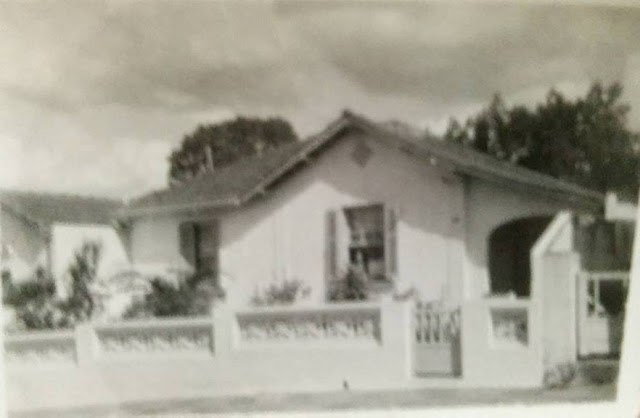rua Coronel Galdino corner of rua 4 de Abtril - 1940s.
Avenida Brasil seen from rua Paraná in the 1970s.
typical house made out of timber planks.
What is it? Is it a ship? No, it's just an architect's dream: a house built at the junction of two streets. The one on the left is Avenida Sampaio Vidal and the one on the right is Rua 4 de Abril. It was demolished in the 1970s to have a bridge built on its place to cross over to the other side of the train line. This bridge has been torn down in the 2000s.
Gasoline station at the corner of Rua Duque de Caxias and Rua Coronel Galdino de Almeida circa 1940 or even earlier.
MARILIA'S GRAVE YARD
this is an early shot of
Cemiterio da Saudade that was built in the outskirts of town in the mid-1920s. My grandfather Giovanni Battista Darin arrived in Marilia with his family in November 1927. Less than a year later on
20th September 1928 his brother Francesco Darin died and was buried near the main gate which shows prominently on the photo. Toni Darin's toddler Antonio Darin Filho died on
20 September 1929 and then Elisa & Rissieri Darin's only daughter Lilia Therezinha died a month later on
25 October 1929 and were all buried in the same grave near the main entrance. Part of the Darin family was really scared of so many deaths and decided to go back to São José do Rio Pardo where they had come from about 2 years before and the graves were left unattended.
In the
1940s the local Council (Prefeitura) built a
new brick wall around the Cemetery and those graves near the entrance were either transfered or simply destroyed with the remaining bones being taken and thrown into a common grave they called 'Cruzeiro' (Crosses). At Dia-dos-Finados (All Souls' Day) on 2nd November people usually light candles near this mass-grave that burn the whole day. The grave-yard management makes sure the fire is put out before they close down at the end of the day.
Praça Athos Fragata 1973 - some comments about this photo done at facebook:
Jarnaldo Nunes: 'Buscávamos água no Poço Artesiano da Anderson Clayton, ao lado do Estádio e entregávamos o leite produzido no sitio para pausterização Iacri na Tiradentes; estrada de terra assim como a estradinha que hoje é a Avenida Esmeralda';
Luiz Japa Sakaghute Costa: 'Olha o ônibus do Jockey Club!
Mauricio Diniz: ...'e o coreto lá no fundo!'
João Camilo: 'Cruzei essa passagem em 1963, às 22 horas com uma carroça de roda de madeira, raiada, puxada por um cavalo e uma mula, vinda água da Fanchona-Echaporã, com destino a Dirceu. Me lembro que a Anderson Clayton tinha sempre um aroma muito agradável!'
Wanda Queiroz Ferreira: 'Quantas vezes fomos buscar água na
Anderson Clayton indo pela Rua Vicente Ferreira... morávamos na Rua Goiáz!!'
Akikazu Tane: 'Me levou à minha
infância e juventude. Morava no início da Av. Pedro de Toledo, bem próximo a
essa passagem-de-nivel. A turma da rua jogava futebol no gramado da Anderson
& Clayton e à tarde, às 17:00 passava o trem de passageiros que vinha de
São Paulo.'
Nelson Fukai: Foi nessa passagem que, por volta de 1966-1967, um Kombi com torcedores do Garça F.C. foi apedrejada pelos torcedores do São Bento F.C., o que estremeceu a relação entre as duas cidades. Lembro que tinha uns jovens garcenses que faziam o curso Cientifico no Instituto de Educação e sofreram alguma perseguição. A selvageria das torcidas de futebol já existia naquela época.
Maria Angela Asperti Nardi: Meu pai tinha máquina de beneficiar arroz em frente a antiga Melhoramentos, na Avenida Tiradentes. Acho que não tinha esse nome ainda. Um dia, vinha minha mãe com sua perua Rural Willys, azul-e-branca, com duas filhas dentro. A Rural afogou justo em cima da linha do trem e foi o tempo de sair com as meninas, o trem arrastou a perua. Foi um belo susto pois os funcionários da Máquina gritavam que o trem tinha pegado minha mãe.
Rua Prudente de Morais entre a XV de Novembro e a 24 de Dezembro; a erquerda o jardim da casa do Dr. Coriolano de Carvalho e a casa dos Chaia (Gilberto Giometti's info. on Facebook).
Serraria Casadei in 1952; according to Gilberto Casadei de Baptista: the saw-mill was at the block formed by rua
Nelson Spielmann, rua
Almirante Barroso, rua
Osvaldo Cruz e rua
Pedro de Toledo. Owned by my grand-father Marino Casadei & his brothers Lazarino and João.

















































